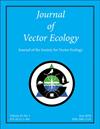Predator selection and predator-prey interactions for the biological control of mosquito dengue vectors in northern Vietnam
IF 1.3
3区 农林科学
Q2 ENTOMOLOGY
引用次数: 1
Abstract
ABSTRACT: Predators and their interactions with target prey influence the efficiency of control strategies. In the present study, we demonstrate the implementation of natural predator selection for controlling dengue vectors in northern Vietnam through field-based observation of aquatic insect predators in natural habitats and lab-based assessment of predatorial capacities for several aquatic insect predators. The selected species was then used to evaluate the predatory-prey interaction using functional responses (FRs) toward 3rd- and 4th-instar larvae of four major medical mosquito species (Aedes aegypti, Aedes albopictus, Culex quinquefasciatus, and Anopheles minimus). The preference of selected predators for Ae. aegypti larvae over other mosquito larvae was also investigated. Both field observation and lab experiments indicated that the giant water bug Diplonychus rusticus was abundant and exhibited the highest predatory capacity for mosquito larvae. The predator exhibited type II FRs when offered each of the four prey species, and the greatest attack rates were observed for Ae. aegypti and Ae. albopictus, with only negligible differences observed in the handling times of the prey species. Further, Manly's selectivity (α) values calculated from the prey choice experiments showed that Ae. aegypti was preferred over both Cx. quinquefasciatus and An. minimus. Together, these findings indicate that D. rusticus could be successfully used to facilitate the biological control of both Ae. aegypti and Ae. albopictus within the species' distributional overlap in Southeast Asia.越南北部蚊媒登革热生物防治的捕食者选择和捕食者-猎物相互作用
摘要:捕食者及其与目标猎物的相互作用影响控制策略的效率。在本研究中,我们通过对自然栖息地水生昆虫捕食者的实地观察和对几种水生昆虫捕食能力的实验室评估,展示了在越南北部实施自然捕食者选择以控制登革热媒介。利用对4种主要医学蚊(埃及伊蚊、白纹伊蚊、致倦库蚊和小按蚊)3龄和4龄幼虫的功能反应(FRs),对所选物种进行捕食-被捕食相互作用评价。伊蚊对天敌的偏好。埃及伊蚊幼虫对其他蚊子幼虫的影响也进行了调查。野外观察和室内实验均表明,大水蝽rusticus数量丰富,对蚊虫幼虫的捕食能力最强。当被提供四种猎物时,捕食者均表现出II型FRs,并且观察到伊蚊的攻击率最高。埃及伊蚊和伊蚊。白纹伊蚊,在处理猎物种类的时间上只有微不足道的差异。此外,从猎物选择实验中计算出的曼利的选择性(α)值表明,伊蚊对猎物的选择性较低。埃及伊蚊比Cx和Cx都更受欢迎。致倦库蚊和安。最年轻的。综上所述,这些发现表明rusticus可以成功地用于促进对伊蚊和伊蚊的生物控制。埃及伊蚊和伊蚊。白纹伊蚊在东南亚的分布重叠。
本文章由计算机程序翻译,如有差异,请以英文原文为准。
求助全文
约1分钟内获得全文
求助全文
来源期刊

Journal of Vector Ecology
生物-昆虫学
CiteScore
2.60
自引率
5.90%
发文量
31
审稿时长
6-12 weeks
期刊介绍:
The Journal of Vector Ecology is an international journal published by the Society for Vector Ecology. It is concerned with all aspects of the biology, ecology, and control of arthropod and vertebrate vectors and the interrelationships between the vectors and the agents of disease that they transmit. The journal publishes original research articles and scientific notes, as well as comprehensive reviews of vector biology based on presentations at Society meetings. All papers are reviewed by at least two qualified scientists who recommend their suitability for publication. Acceptance of manuscripts is based on their scientific merit and is the final decision of the editor, but these decisions may be appealed to the editorial board. The journal began publishing in 1974 and now publishes on-line only.
 求助内容:
求助内容: 应助结果提醒方式:
应助结果提醒方式:


